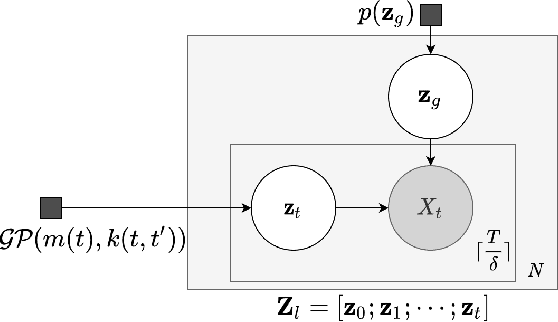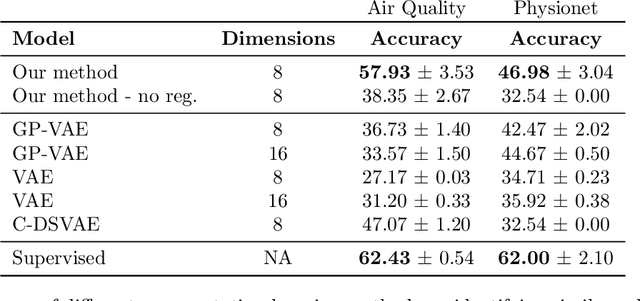Sana Tonekaboni
Machine Learning for Health symposium 2024 -- Findings track
Mar 02, 2025Abstract:A collection of the accepted Findings papers that were presented at the 4th Machine Learning for Health symposium (ML4H 2024), which was held on December 15-16, 2024, in Vancouver, BC, Canada. ML4H 2024 invited high-quality submissions describing innovative research in a variety of health-related disciplines including healthcare, biomedicine, and public health. Works could be submitted to either the archival Proceedings track, or the non-archival Findings track. The Proceedings track targeted mature, cohesive works with technical sophistication and high-impact relevance to health. The Findings track promoted works that would spark new insights, collaborations, and discussions at ML4H. Both tracks were given the opportunity to share their work through the in-person poster session. All the manuscripts submitted to ML4H Symposium underwent a double-blind peer-review process.
An Information Criterion for Controlled Disentanglement of Multimodal Data
Oct 31, 2024Abstract:Multimodal representation learning seeks to relate and decompose information inherent in multiple modalities. By disentangling modality-specific information from information that is shared across modalities, we can improve interpretability and robustness and enable downstream tasks such as the generation of counterfactual outcomes. Separating the two types of information is challenging since they are often deeply entangled in many real-world applications. We propose Disentangled Self-Supervised Learning (DisentangledSSL), a novel self-supervised approach for learning disentangled representations. We present a comprehensive analysis of the optimality of each disentangled representation, particularly focusing on the scenario not covered in prior work where the so-called Minimum Necessary Information (MNI) point is not attainable. We demonstrate that DisentangledSSL successfully learns shared and modality-specific features on multiple synthetic and real-world datasets and consistently outperforms baselines on various downstream tasks, including prediction tasks for vision-language data, as well as molecule-phenotype retrieval tasks for biological data.
A collection of the accepted papers for the Human-Centric Representation Learning workshop at AAAI 2024
Mar 14, 2024Abstract:This non-archival index is not complete, as some accepted papers chose to opt-out of inclusion. The list of all accepted papers is available on the workshop website.
Learning from Time Series under Temporal Label Noise
Feb 06, 2024Abstract:Many sequential classification tasks are affected by label noise that varies over time. Such noise can cause label quality to improve, worsen, or periodically change over time. We first propose and formalize temporal label noise, an unstudied problem for sequential classification of time series. In this setting, multiple labels are recorded in sequence while being corrupted by a time-dependent noise function. We first demonstrate the importance of modelling the temporal nature of the label noise function and how existing methods will consistently underperform. We then propose methods that can train noise-tolerant classifiers by estimating the temporal label noise function directly from data. We show that our methods lead to state-of-the-art performance in the presence of diverse temporal label noise functions using real and synthetic data.
Time-Varying Correlation Networks for Interpretable Change Point Detection
Nov 08, 2022Abstract:Change point detection (CPD) methods aim to detect abrupt changes in time-series data. Recent CPD methods have demonstrated their potential in identifying changes in underlying statistical distributions but often fail to capture complex changes in the correlation structure in time-series data. These methods also fail to generalize effectively, as even within the same time-series, different kinds of change points (CPs) may arise that are best characterized by different types of time-series perturbations. To address this issue, we propose TiVaCPD, a CPD methodology that uses a time-varying graphical lasso based method to identify changes in correlation patterns between features over time, and combines that with an aggregate Kernel Maximum Mean Discrepancy (MMD) test to identify subtle changes in the underlying statistical distributions of dynamically established time windows. We evaluate the performance of TiVaCPD in identifying and characterizing various types of CPs in time-series and show that our method outperforms current state-of-the-art CPD methods for all categories of CPs.
Decoupling Local and Global Representations of Time Series
Feb 11, 2022



Abstract:Real-world time series data are often generated from several sources of variation. Learning representations that capture the factors contributing to this variability enables a better understanding of the data via its underlying generative process and improves performance on downstream machine learning tasks. This paper proposes a novel generative approach for learning representations for the global and local factors of variation in time series. The local representation of each sample models non-stationarity over time with a stochastic process prior, and the global representation of the sample encodes the time-independent characteristics. To encourage decoupling between the representations, we introduce counterfactual regularization that minimizes the mutual information between the two variables. In experiments, we demonstrate successful recovery of the true local and global variability factors on simulated data, and show that representations learned using our method yield superior performance on downstream tasks on real-world datasets. We believe that the proposed way of defining representations is beneficial for data modelling and yields better insights into the complexity of real-world data.
Unsupervised Representation Learning for Time Series with Temporal Neighborhood Coding
Jun 01, 2021



Abstract:Time series are often complex and rich in information but sparsely labeled and therefore challenging to model. In this paper, we propose a self-supervised framework for learning generalizable representations for non-stationary time series. Our approach, called Temporal Neighborhood Coding (TNC), takes advantage of the local smoothness of a signal's generative process to define neighborhoods in time with stationary properties. Using a debiased contrastive objective, our framework learns time series representations by ensuring that in the encoding space, the distribution of signals from within a neighborhood is distinguishable from the distribution of non-neighboring signals. Our motivation stems from the medical field, where the ability to model the dynamic nature of time series data is especially valuable for identifying, tracking, and predicting the underlying patients' latent states in settings where labeling data is practically impossible. We compare our method to recently developed unsupervised representation learning approaches and demonstrate superior performance on clustering and classification tasks for multiple datasets.
What went wrong and when? Instance-wise Feature Importance for Time-series Models
Mar 05, 2020



Abstract:Multivariate time series models are poised to be used for decision support in high-stakes applications, such as healthcare. In these contexts, it is important to know which features at which times most influenced a prediction. We demonstrate a general approach for assigning importance to observations in multivariate time series, based on their counterfactual influence on future predictions. Specifically, we define the importance of an observation as the change in the predictive distribution, had the observation not been seen. We integrate over plausible counterfactuals by sampling from the corresponding conditional distributions of generative time series models. We compare our importance metric to gradient-based explanations, attention mechanisms, and other baselines in simulated and clinical ICU data, and show that our approach generates the most precise explanations. Our method is inexpensive, model agnostic, and can be used with arbitrarily complex time series models and predictors.
What Clinicians Want: Contextualizing Explainable Machine Learning for Clinical End Use
May 13, 2019
Abstract:Translating machine learning (ML) models effectively to clinical practice requires establishing clinicians' trust. Explainability, or the ability of an ML model to justify its outcomes and assist clinicians in rationalizing the model prediction, has been generally understood to be critical to establishing trust. However, the field suffers from the lack of concrete definitions for usable explanations in different settings. To identify specific aspects of explainability that may catalyze building trust in ML models, we surveyed clinicians from two distinct acute care specialties (Intenstive Care Unit and Emergency Department). We use their feedback to characterize when explainability helps to improve clinicians' trust in ML models. We further identify the classes of explanations that clinicians identified as most relevant and crucial for effective translation to clinical practice. Finally, we discern concrete metrics for rigorous evaluation of clinical explainability methods. By integrating perceptions of explainability between clinicians and ML researchers we hope to facilitate the endorsement and broader adoption and sustained use of ML systems in healthcare.
 Add to Chrome
Add to Chrome Add to Firefox
Add to Firefox Add to Edge
Add to Edge